A funerary palanquin was once regarded as the exclusive privilege of royalty, and until recently, could only be paraded in public with permission of the king.[1] One of the oldest detailed descriptions of an Indian royal funeral culminating in the collection of bones and ashes, that of King Daśaratha, father of Rāma, in Vālmīki's Rāmāyaṇa (Rām) II.65-77, mentions a funeral palanquin, or śibikā, used for the procession of the corpse to the cremation ground (II.76.14). Waldschmidt (1948: 273, 344f.) pointed to the close analogy between the basic sequence of events in the description of Daśaratha's funeral and accounts of the funeral of the Buddha, who apparently instructed his disciples to have it conducted in the same way as the funeral for a universal monarch (cakkavatti), "the wheels of whose chariot roll everywhere without obstruction." The comparison of different recensions of the ancient Buddhist Mahāparinirvāṇasūtra (MPS) and parallel passages in the Sūtrapiṭikas and Vinayapiṭikas by Waldschmidt (1944-48, 1950-51) and Bareau (197071) showed that of the MPS only the Sanskrit[2] and in particular relatively late Chinese versions include depictions of a funeral palanquin, also called śivikā, but not the Pāli account.[3] Waldschmidt highlighted that, contrary to the epic narrative of Daśaratha's funeral, the accounts of the funeral of the Buddha are all adorned with miracle stories, and, besides humans, allocate major roles to the gods. In the oldest and effectively paradigmatic depiction of the funeral of the first jina, Ṛṣabha, in Jambuddīvapaṇṇatti (JDP) II, the proceedings are conducted exclusively by gods. Here, the common trend towards progressive idealisation of cultural heroes in the three main ancient South Asian religions has reached its logical conclusion. Even ordinary Jaina mendicants have been superhumanised to an unprecedented degree.
Nowadays, it is an established Jaina custom to honour exemplary Jaina mendicants, as well as exceptional laity, who performed the fast to death (sallekhanā), with a festive funeral procession to the cremation ground in an extravagant royal-style palanquin, where the corpse inside the palanquin will be reduced to ashes in a visually compelling act of transformation through fire. In contrast to the solemn funeral of a common Jaina lay person, whose dead body is carried by male family members to the funeral pyre on a simple bier, in a lying posture, covered from head to toe by a shroud, the funeral of a Jaina ascetic, who purposefully purified and finally "liberated" the soul from its fetters to achieve salvation or at least a better rebirth, is a joyous occasion. The corpse is carried on the shoulders of leading male representatives of the local Jaina community, behind an orchestra playing exuberant tunes, in a decorated funeral palanquin, resembling a royal litter, covered with a canopy, shaped like a palace or a temple,[4] in a cross-legged, upright meditative posture, with the face exposed.

Fig. 1
Ācārya Mahāśramaṇa of the Śvetāmbara Terāpanth in front of the baikuṇṭḥī of his predecessor Ācārya Mahāprajña, Sardārśahar 10.5.2010 (Photo Babluji)
The practice of constructing funeral palanquins for Jaina ascetics is shared amongst both Śvetāmbaras and Digambaras today.[5] There are only slight stylistic variations. Digambaras, it seems, have a preference for less ostentatious designs, such as uncovered throne-like wooden seats, that are placed on a simple bier. The use of such vehicles, or vimānas, called baikuṇṭhī in Rājasthān, is documented already in the earliest eye-witness report of a Śvetāmbara monastic funeral of the 12th century, which depicts a multi-levelled structure, made of sandalwood and decorated with auspicious pots (kalasa) and flags (dhaya), without offering details on the position of the corpse.[6] Such a public procession of a dead body in a sitting posture, placed in a funeral palace draped with royal symbols, above all kalaśas and dhvajas, demands attention and asserts a claim to high status: not only for the deceased, but for the community as a whole.[7] (Fig.4) Processions are therefore carefully monitored, and frequently barred, by political authorities.
In India, the procession of the body of a person in a sitting posture, alive or dead, was once restricted to royalty.[8] It could be mimicked only with special permission, as the following observations on the funeral procession of the Terāpanth ācārya Jītamala (Jāyācārya) (1803-1881) in Jaipur also demonstrate:
It was the first case in Jaipur state that the body of a person other than royalty was taken in sitting posture in a procession for cremation. It became possible only because the Srawakas got prior approval from the Maharaja of Jaipur (Sharma 1991: 179f.).
As a rule, in Hinduism, Buddhism, and in ordinary Jaina funerals, corpses are not carried in an upright position.[9] Even kings are usually transported to the funeral ground in a lying position, with their face covered. The corpse of the Buddha, too, is always represented in a lying posture. The significance attached to the sitting posture therefore indicates that the underlying comparison is rather between a parade of a living king, conveyed on the shoulders of men in a comfortable chair (sukhāsana), and the procession of a dead Jaina ascetic, who is claimed to have been reborn as a king in the upper world. Unlike the relatively modest though ostentatiously adorned vimānas of Jaina mendicants (Fig. 1-2), royal funeral palanquins can be huge palace-like structures, with towering spires, which require hundreds of men to be carried. Grand royal-style funeral palaces are nowadays used in Buddhist monastic funerals as well. Yet, the exposed sitting posture of the deceased, the open display of the face, and the prescribed absence of mendicants during the funeral procession and cremation seem to be features unique to the funerals of Jaina ascetics. For ordinary Jaina cremations, by contrast, a modest bier (siḍī or sīḍī) is constructed out of bamboo sticks, which are laid out in form of a ladder as its name indicates (siḍī=sīṛhī), and the body is cremated with slight variations in a standard modern Hindu fashion.
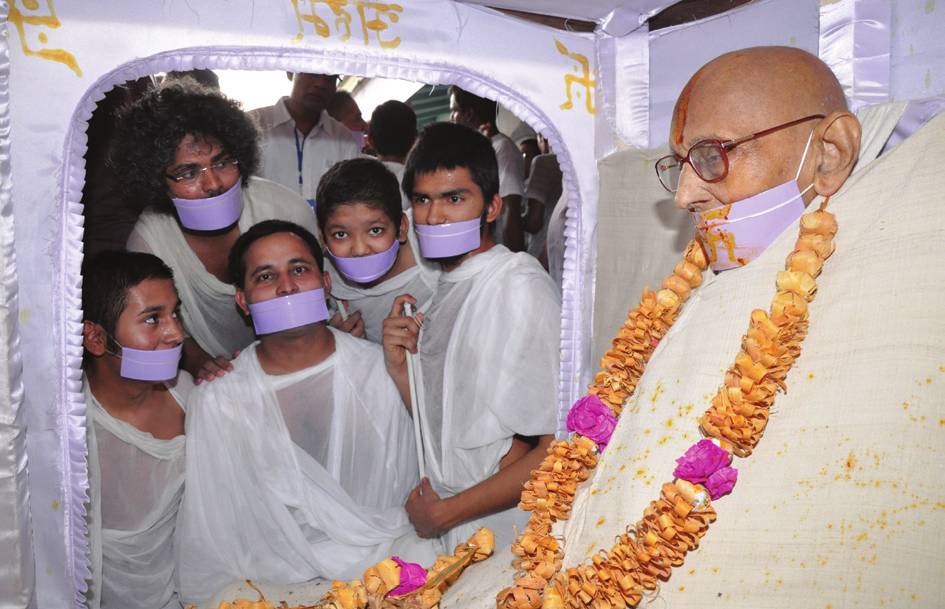
Fig. 2
Ācārya Mahāprajña inside his baikuṇṭḥī, Sardārśahar 10.5.2010 (Photo: Babluji)
The origins of this practice are obscure. With the emergence of the concept of the fourfold community (cāturvarṇya-śramaṇa-saṅgha), possibly as late as the 4th century CE (Viy 20.8.5), Jaina mendicants officially assumed the status of spiritual rulers for their followers, which they must have enjoyed for centuries, and began to be treated and addressed as kings (mahārāja), and allegorically depicted as such in Jaina literature and iconography.[10] However, because the use of regal symbols is prohibited for Jaina mendicants, the outward trappings of royalty can only be attached to them for brief moments, before initiation and after death, which must have motivated the creation of extended rituals for these occasions. They are usually organised by lay devotees, to publicly celebrate Jaina values, and their representatives, with permission of the Jaina ācāryas and the local authorities. Apart from the brief keywordlists Āvassayanijjutti (ĀvN) 206, 366 & 435, the oldest and effectively paradigmatic depictions of funeral rituals for Jaina mendicants are the descriptions of the legendary collective cremation of the jiṇa Usabha (Ṛṣabha), his gaṇaharas, and ordinary monks (aṇagāra) in the Śvetāmbara Āgama text Jambuddīvapannatti (JDP1) 2.101 (= JDP2 2.43), composed around the 4th century C.E. and echoed by Jinadāsa Gaṇin Mahattara's 7th-century Āvassayacuṇṇi (ĀvC) p. 222, and the first Digambara version, Jinasena's 9th-century Sanskrit universal history Ādipurāṇa (ĀP) 47.343f. All these texts use the words siviyā or sīyā (Skt. śibikā or śivikā) for the funeral palanquins; a term without obvious eschatological overtones, which is also employed in the Śvetāmbara canon as a designation for the palanquins used for carrying mendicants-to-be to their sites of initiation. JDP 2.101 alone presents information on the elaborate ornamentation of the funeral palanquins with paintings of animals, human beings, kinnaras (half-human, half horse), Mt. Aṣṭāpada, and flywhisks. Decorations of this kind could not be applied to a plain bier. It therefore has to be assumed that at the time of the creation of this text elaborate Jaina funeral rites and the use of funeral palanquins for prominent monks had already come into existence, at least in the Śvetāmbara tradition. ĀP 47.343f. merely mentions that the "best palanquin" was used, in recognition of the extraordinary qualities of Ṛṣabha's body, which had been productive of the liberation of his soul (mokṣa-sādhana).
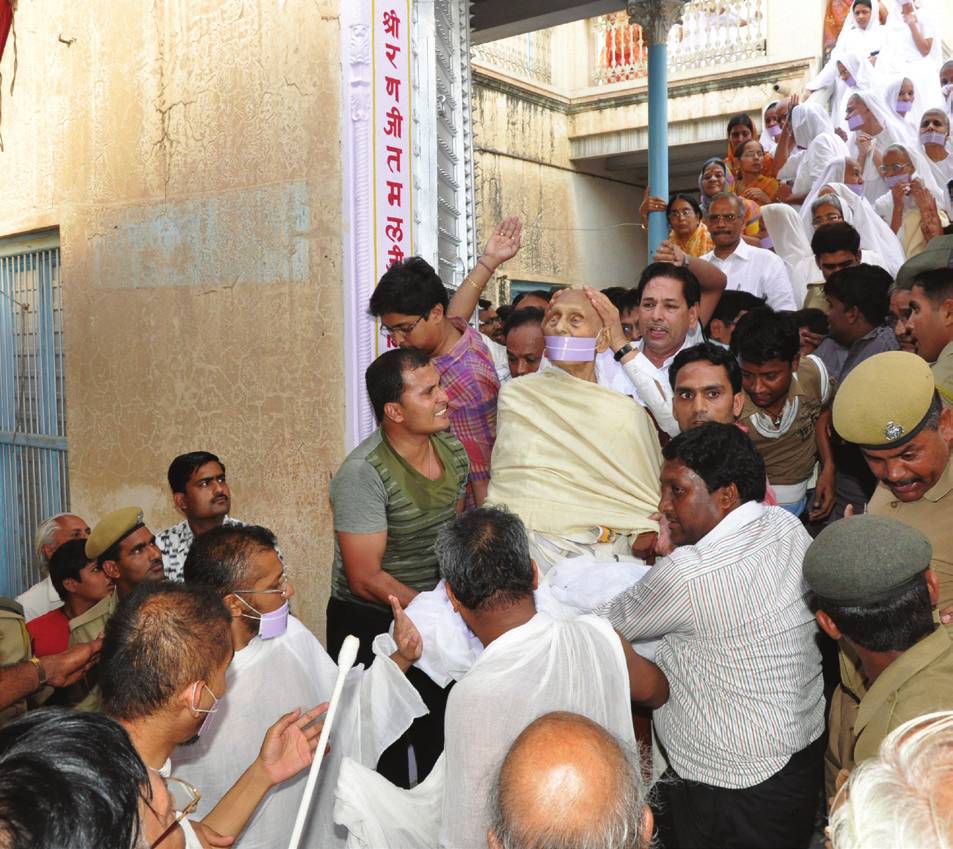
Fig. 3
Removal (nirharaṇa) of the body of Ācārya Mahāprajña from his abode, Sardārśahar 10.5.2010 (Photo: Babluji)
A few basic rules for the removal of the corpse of a common mendicant had been prescribed already in the late early-canonical Kappa (BKS) 4.24 and in its commentaries, especially Saṅghadāsa's 6th century Kappabhāsa (Bṛhatkalpabhāṣya) (BKB) 5497-5565, and in the Digambara text Bhagavaī-Ārāhaṇā (BhagavatīĀrādhanā) (BhĀ), composed by Śivārya in the 1st century CE or later, which in v.1973 uses the word siviyā for a funeral litter. Instead of a paradigmatic high-class cremation for a legendary Jina, the BhĀ and the BKB prescribe in great detail and in an entirely similar manner the alternative and presumably older procedure of simply discarding the dead body of a common monk in the forest. BKB vv. 5503 additionally specifies the materialssolid and smooth bamboo (veṇu) and wood (dāru)for the "implement" (uvagaraṇa) which BKS 4.24 recommends to be used by mendicants to carry the corpse outside the abode, if a monk dies at night and no householders are present.
The term sīyā, the short form of sibiyā or siviyā, is used in Samavāya (Sam) Paiṇṇa 224 to designate the individual palanquins used to carry each of the 24 Jinas to the sites where they renounced the world (ṇikkamaṇa). The name of the palanquin of each Jina is enumerated. Usabha's, for instance, was called "Sudaṃsaṇā"(Goodlooking), and Mahāvīra's, "Caṃdappabhā" (Moonlight). The unusual anthropomorphisation of the quasi-royal vehicles used by the noble-born future Jinas during their procession to the site of renunciation indicates the symbolic significance attached to them in the context of newly developed Jaina initiation ceremonies. Specific ornaments are not mentioned, only that the palanquins were comfortable in all seasons (savvotuka-subha) and of great beauty (chāyā). However, details on ornamentation are given in another exemplary story concerning an ordinary monk. In the late-canonical Nāyādhammakahāo (NDK I.128-144), the stately palanquin used to carry Prince Meha to the site of his initiation (pavvāvaṇa), by Mahāvīra, following portable displays of "the eight auspicious symbols" (aṭṭha-maṃgala), is simply identified as a "thousand-man-palanquin" (purisasahassa-sīyā). The specifications for its attractive decorative paintings echo those of the funeral palanquin given in the JDP. Additionally, numerous pillars (khaṃbha) are mentioned, suggestive of a multi-levelled structure. They are described as being adorned not only with paintings, but also with bells (ghaṃṭā), gems (rayaṇa), and puppets of playful dancing girls (līlaṭṭhiyasālabhaṃjiyā). During the procession itself five beautiful young maidens (vara-taruṇī) were positioned around Meha, holding flywhisks (cāmara), a palmleaf fan (tālaviṃṭa), a silver water pitcher (bhiṃgāra), and a large white parasol (āyavatta) (indicating that this palanquin was not imagined to have been covered by a canopy), which are all royal symbols (NDK I.129).[11]
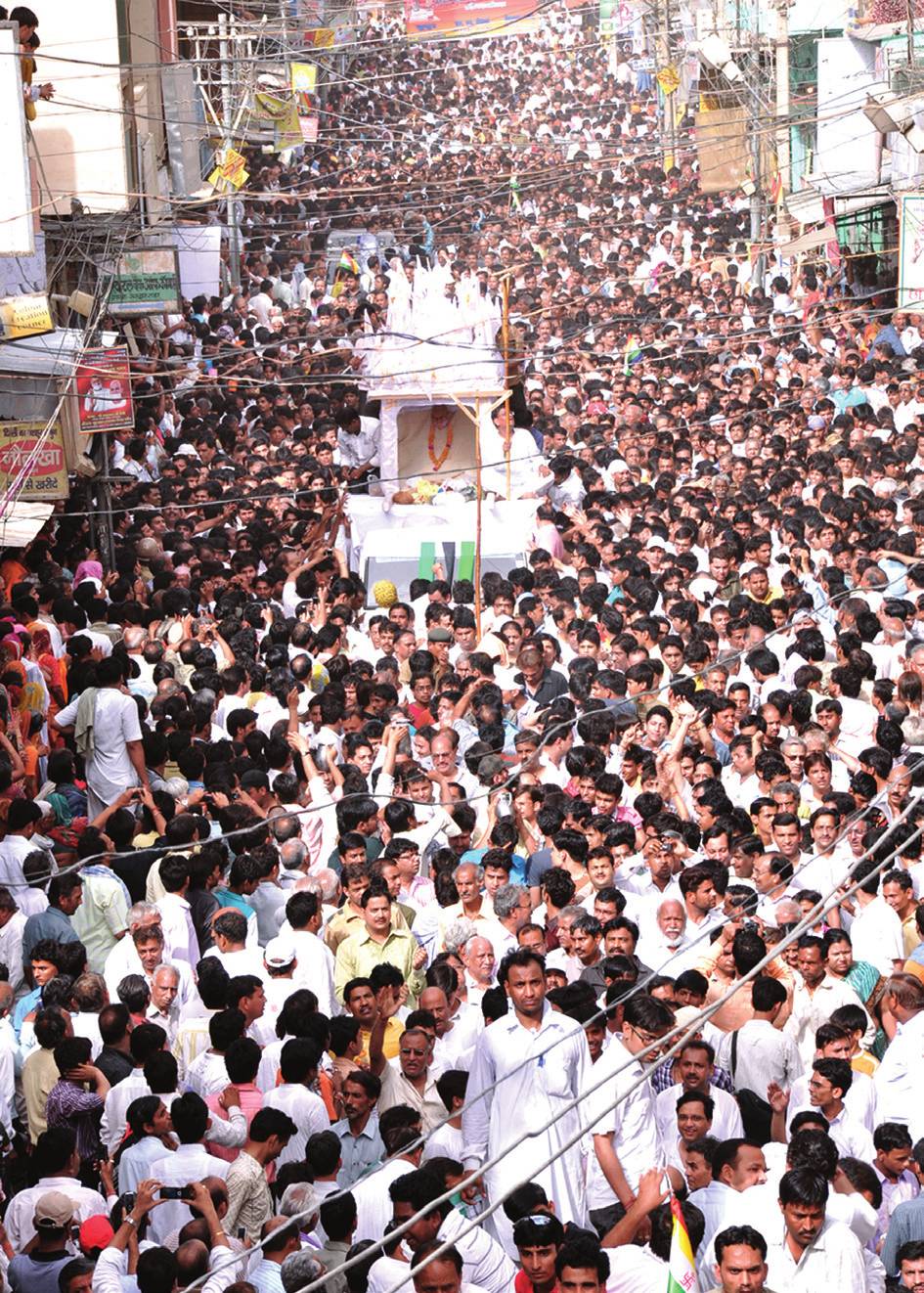
Fig. 4
Funeral procession of Ācārya Mahāprajña, Sardārśahar 10.5.2010 (Photo: Babluji)
The puppets of dancing girls and the presence of young maidens allude to the alternative wedding procession, which is conducted in a similar way. In Hindu contexts, the funeral of an old person who died a "good death" is also sometimes joyously celebrated and described as "their 'second wedding' and their funeral procession as a baratas a marriage party" (Parry 1994: 155, 157). In contrast to the ban on the participation of women in common Jaina and Hindu funeral processions, females take part in the funerals of Jaina ascetics. As in the dīkṣā-yātrā, the emphasis is not on the negative aspects of renunciation or death, but on the positive potential to create new relationships. The hope for a victory over attachment is expressed by the prevalence of royal symbolism in weddings and Jaina initiations and funerals. Proof for the pervasiveness of this supposition is furnished by a Chinese version of the MPS, according to which, during the funeral procession of the Buddha, young girls held a canopy (cailavitāna),banners (dhvaja) and parasols (chattra) over the funerary litter (śivikā).[12] It again demonstrates that the symbolical role of young girls or artistic representations thereof is to accentuate the obligatory celebratory mood of the occasion, not to mark the difference between a wedding, an initiation or a funeral.
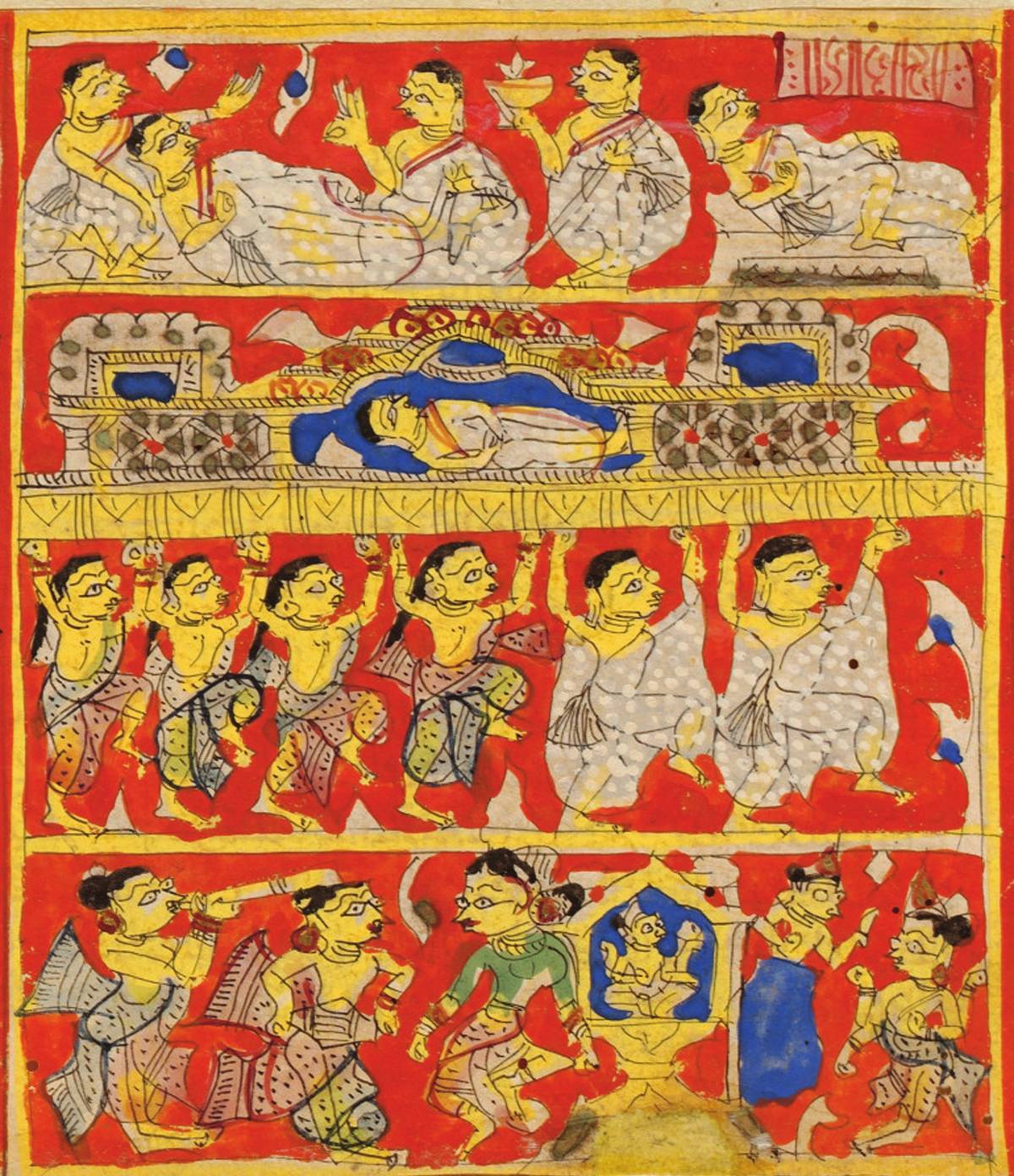
Fig. 5
Uttarādhyayanasūtra: Akāmamaraṇijjaṃ (Detail) Cambay, Gujarat, ca. 1460, © Victoria and Albert Museum, Museum Number: IS.2:5/2-1972
Cremation of the corpse in a meditative cross-legged "lotus posture" (padmāsana), acommon today, could be an even later development (as in Hindu ascetic burials): as late as the 19th century in the Terāpanth tradition, judging by the evidence concerning Jayācārya's funeral. Two published manuscript illustrations, each depicting a dead Jaina mendicant in a lying posture, may be indicative, though more research is required on this question. The first image, an illustration of Uttarajjhāyā 5 in a 15th-century Gujarātī Mūrtipūjaka manuscript, depicts the sumptuous procession of a dead monk lying on his back inside an ornate canopied funeral palanquin, as in any upper class Hindu funeral procession, but with his head uncovered, and, exceptionally, carried by both laity and monks (possibly indicating that this scene depicts the initial disposal, nirharaṇa, of the corpse by the monks, cf. Fig. 3), while the second, from an 18thcentury Rājasthānī Sthānakavāsī manuscript, shows a corpse lying on a simple wooden bājoṭ, wrapped completely in white cloth, including the face, as in a common contemporary Hindu funeral.[13] The ancient Jaina texts remain silent on this point.
The so-called baikuṇṭhī used by Jainas in Rājasthān today is a wooden structure made of a base of two joined carrying poles and a rectangular canopy, with a ribvaulted dome made of bamboo rods conjoined by a pivotal timber nexus.(Fig.6) The timber skeleton is internally and externally embroidered with shining fabric and the pinnacles of the dome are decorated with metal pots and flags. Its conventional shape mimics a (mahā-) prāsāda, a temple or throne cum heavenly palace, literally "a seat in a conspicuous place."[14] It is also called deva-vimāna, "vehicle-" or "palace of the gods,"[15] because it represents a means of transport for a god's journey to heaven (devaloka) (as it were via the smoke of the cremation fire). This is indicated by the Rājasthānī synonyms bekuṇṭhī, baikuṇṭhī and vaikuṇṭhī, which derive from the Sanskrit adjective vaikuṇṭhīya: "relating to Viṣṇu's heaven" in the sense of "leading to Viṣṇu's heaven." Standard Sanskrit and Prakrit dictionaries and glossaries of Jaina technical terms do not offer information on the term vaikuṇṭhī. However, in Rājasthānī, according to Lālas (1986-7 II: 664), the vernacular word vaikuṇṭḥī designates: (1) (a) a funeral litter (pālakī-numā śavayāna) or bier (arathī, rathī, ratha), (b) a wealthy person (arthī), or (2) vaikuṇṭha (from vi-kuṇṭha, "irresistible"), an epithet of (a) Viṣṇu (Kṛṣṇa), (b) Viṣṇu's highest heaven, palace or abode, (c) Indra, (d) Tulasī, (e) (a special class of) the gods. Patel (1986: 163ff.) pointed out that the word vaikuṇṭḥa was first associated with Indra in late-Vedic texts. Later vaikuṇṭha became an epithet of Viṣṇu, and the "story attached to Indra has been transferred to Viṣṇu" (p. 168). Finally, the concept of a vaikuṇṭha heaven, the abode of Viṣṇu, was created around the 9th-10th centuries, and further developed in later Purāṇas, such as the Bhāgavatapurāṇa. As a transferred epithet of Indra the use of the word baikuṇṭhī for Śvetāmbara Jaina funeral palanquins may even be older than the 9th century, given that middle- and late-canonical texts already tell us that, as a rule, the souls of Jaina mendicants swiftly travel to and are reincarnated in the upper world (ūrdhva-loka) as Indras and Indrāṇīs or other powerful heavenly beings.
The visible enactment of the soul's imagined ascent to heaven (vaikuṇṭha-gati) by means of the ceremonial quasi-sacrificial destruction of a funeral palace by fire (and its imaginary transformed recreation in the upperworld) demonstrates the continuing influence of Vedic imagery on the Jaina (and Buddhist) funeral ritual. The jainised use of the word baikuṇṭhī for a Jaina funeral palace is itself an example for the complex co-evolution of Hindu and Jaina religious cultures. Although the names of their heavens differ, both traditions agree that with the help of heavenly palaces the gods can travel at will and very fast throughout the cosmos. The paradigmatic Jaina depiction of such a vimāna is the god Sūriyābha's palace described in the Rāyapaseṇaijja (Rāy 200g).
The iconography of the baikuṇṭhī is also symbolically associated with the portable shrines used for processions of tīrthaṅkara statues, and others, which are also called vimāna. They resemble the gandhakuṭī, the legendary "perfumed chamber" of the Jinas, which is imagined as a "pavilion (open on 4 sides) on a dais in the centre of a Samavasaraṇa" (Shah 1955 / 1998: 56). The origin and significance of the image of the gandhakuṭī or jinakuṭī as a mythical dwelling place of the Jinas living in the continents of the middle world is still unclear. Norman (1908), Strong (1977: 395) and Schopen (1990 / 1997: 268) showed that from the 4th century CE onwards the gandhakuṭī was "an established part of Buddhist monastic establishments everywhere." It represented the "private chamber reserved for the Buddha" (originally in Śrāvastī), based on the idea of the living presence of the Buddha in the perfumed chamber as a juristic personality, like a Hindu god (p. 272). Buddhist influence on the Jaina iconography of the gandhakuṭī, suggested by Dundas (1991: 177f.), is a strong possibility. Buddhist land grants from the 6th century referring to gandhakuṭīs were found in Valabhī, where the Śvetāmbara canon is said to have been written down in the 5th century. But physical Jaina gandhakuṭīs, comparable to those in Buddhist monasteries, are yet to be located. In the religious imagination, informing the universal histories of the Jainas, the Jinas are nevertheless present as the moral rulers of the universe as a whole, and depicted as such in Jaina art and iconography. Tangible Jaina texts, artefacts and religious paraphernalia, such as the baikuṇṭhī, project the existence of gandhakuṭīs and heavenly vimāṇas that are similar in appearance into regions, such as heavenly realms, parallel continents or mountain peaks that are inaccessible for common human beings.
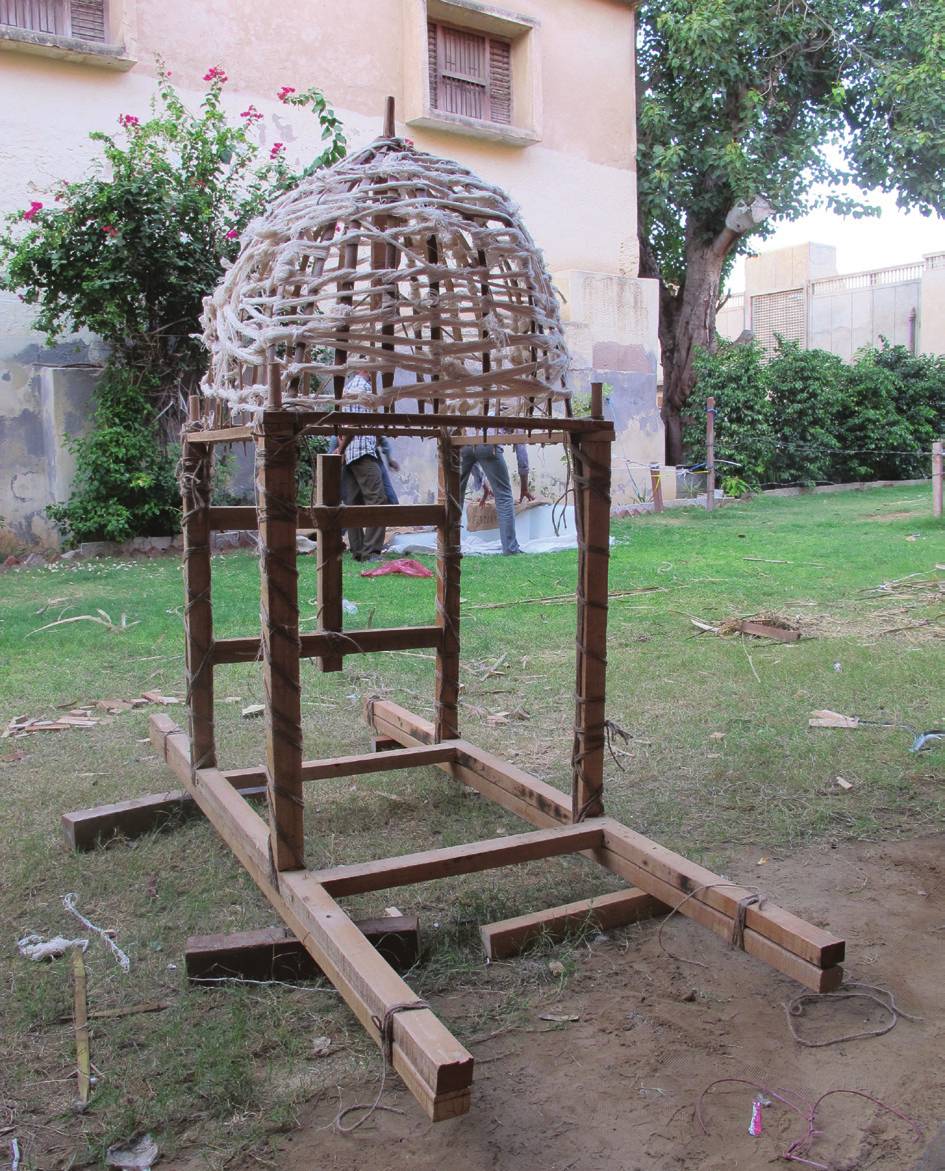
Fig. 6
The baikuṇṭḥī for Smt. Bacchāvat under construction, Sardārśahar 5.10.2014 (Photo: Peter Flügel)
The perfections of the Jinas after attaining omniscience are symbolised by 34 supernatural qualities, or "excellences" (atiśeṣa),[16] which altogether indicate spiritual and physical perfectionamongst them seven of their "eight" miraculously appearing protective symbols called "door-keepers" (aṣṭa-prātihārya).[17] Their iconographical representation culminates in the image of a sacred, i.e., non-violent, renouncer king ruling over the three worlds (tri-loka). From the late-canonical period onwards, the Jina is invariably presented as the one who "goes beyond opposites, and combines both the qualities of a supreme king (cakravartin) and of a spiritual master" (Balbir 1994: 103). This concept is particularly vividly expressed in Śvetāmbara Mūrtipūjaka culture, where the Jina image is generally, at specific occasions, decorated with jewel-studded crowns made of precious metals. The famous depiction of the samavasaraṇa, the congregation of the Jina, in ĀP 22.76-312 echoes the paradigmatic outline of a heavenly palace (vimāna) in the Rāyapaseṇaijja, whose stereotypical imagery is used again in Hemacandra's (TŚPC 6.566-637) 12th-century description of Ṛṣabha's memorial caitya-stūpa, which he explicitly associates with the samavasaraṇa and its gandhakuṭī at the centre. Shah (1955/1998: 93) concluded from this that, iconographically, "the samavasaraṇa has for its prototype the big stūpa (the harmikā of a stūpa may be compared with a Gandhakuṭi or Devacchand-pīṭha for the Jina);" though the functions of these structures are entirely different.
The observation can be extended to an interpretation of the form and symbolism of the baikuṇṭhī, whose shape echoes the stereotypical gandhakuṭī. With its big palace (mahā-prāsāda), lofty domes (stūpa), pinnacles (śikhara), maṅgala objects, etc., the baikuṇṭhī closely resembles both the vimāna, the palace of a king of the gods, and the stereotypical gandhakuṭī, the palace of a Jina, the supreme ruler of the universe in Digambara and Śvetāmbara universal histories. Royal symbols such as the parasol (chatarī), flag (dhvaja), fly whisk (camara, cāmara) and other auspicious objects, are deliberately used as decoration of the baikuṇṭhīs, besides Jaina svastikas and the syllable oṁ (Fig. 8), to create a close symbolic association between the deceased ascetic and divine kingship.[18] In their symbolic role as chariots baikuṇṭhīs are supreme signs of royalty in their own right. (Fig. 7)
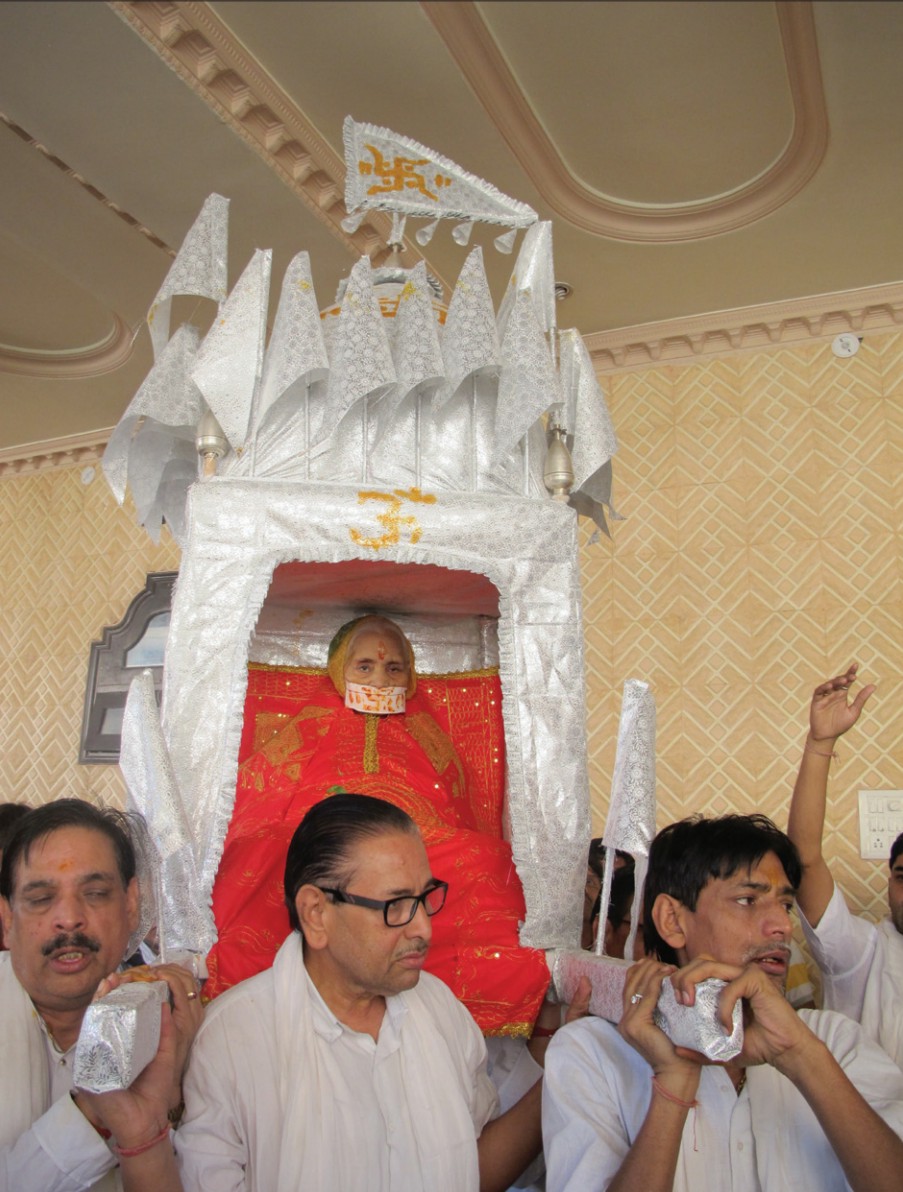
Fig. 7
Baikuṇṭḥī of the śrāvikā Smt. Bacchāvat, Sardārśahar 5.10.2014 (Photo: Peter Flügel)
The design of the baikuṇṭhī of the Terāpanth ācārya Tulsī (1914-1997), who was cremated in Gaṅgāśahar, mimicked the dome-shaped chatrīs, or memorial pavilions, for deceased Rājputs, which can be found all over Rājasthān; though it was open only on three sides, not on four, probably because of the aesthetically unappealing back support to which the corpse was tied with long cotton ropes. The baikuṇṭhī was built by a local firm in the house of the sponsor, who coordinated and financed the work.[19] The following materials and utensils were used: sandalwood (candana), clarified butter (ghṛta), saffron (kesara), camphor (kapūra), rose water (gulāba jala), incense (dhūpa), wooden rods (chaṛchaṛī), pieces of coconut (khoparā), pieces of wood (lakaṛī) of the local khejaṛī tree (Prosopis cineraria), silver (cāṃdī) used for the decorative pots and the mukhavastrikā, sandalwood for the rosary (mālā) in the hands of the deceased, fly whisks (caṃvara), bamboo (bāṃsa), ropes and strings (rassī sūt), a brass container for heating liquids (pītal ke tapelī), two garments for the lower body (dhotī-joṛā), a white shawl, etc. On the silver-coloured dome (gumaṭha) of the baikuṇṭhī and on its backside svastikas and other auspicious symbols (cinha) were painted in golden yellow saffron colour by a member of the local Terāpanth community. Sandalwood garlands were draped from the crest (turrā) and from the 72 pinnacles (śikhara), decorated with pots (kalaśa) made of pure white silver,[20] the number 72 apparently representing Tulsī's monastic age (dīkṣā-paryāya).[21]

Fig. 8
Mrs. Bacchāvat's mouthmask is decorated with a svastika by her son, Sardārśahar 5.10.2014 (Photo: Peter Flügel)
Their latter names vimāṇa and baikuṇṭḥī and the iconography of the Jaina funeral palanquins clearly express the unwritten purpose of the violent funeral rituals organised by Jaina laity for their religious virtuosi today, that is, the symbolic transformation, in the eyes of the devotees, of the ascetic into a powerful indra, or king of the gods. This change of status is pictured as the journey of the soul towards the place of its improved rebirth in the upper world, of which the funeral procession marks, as it were, the beginning.[22] From a Jaina karman-theoretical point of view, the soul already left the body long before the cremation, and the funeral ritual has at best socio-religious functions. The cremation fire is neither the cause of the transformation of the body, as presumed by the sacrificial Vedic cremation (which it outwardly resembles), nor the translocation of the Jaina soul,[23] but merely visualises the alleged dissociation of the soul through the acceleration of the decomposition of the body, its simulacrum, at a time when a vivid image of the deceased still persists. (Fig. 9)
Yet, as a symbolical ritual, the cremation of a Jaina saint has religious functions as well, because it offers participants the opportunity for generating merit (puṇya) by way of anumodana, "approval" or "appreciation," of the accomplished saintly life and the resulting heavenly rebirth of an exemplary personality, whose pursuit of self-restraint has come to fruition. Like the obligatory kāyotsarga meditation, performed by the mendicants after abandonment of the corpse of a deceased monk or nun, cremation rites performed by the laity are believed to trigger forms of self-transformation, if they indeed result in an intensification of the realisation of the Jaina perspective on the transience of worldly life and the immortality of the soul. In the minds of others, the dissociation of soul and body is not as singular event, but a process that is complete only at the point of the visible dissolution of the body, not at the point of death. On the one hand, this explains the purpose of funeral rites, and, on the other hand, the religious priority given to the site of disposal of the body over the site of death. The visualisation of the effects of accumulated good karman as a journey to heaven also invites the conjecture that as a god reborn in the upper world, who still cares about the remains of his former body, the deceased will help his devotees in the middle world. A continuation of the relationship is desired.
Keyes (1975) observed that among Siamese Buddhists (as in Vedic Brāhmaṇism) the cremation itself seems to be considered as a transformational event for the deceased mediating between death and heavenly rebirth, with auxiliary benefits for those who conduct and witness the cremation:
Death transforms the monk not into a threat to the aspects of life most valued but into a vehicle whereby the good life can be achieved both by himself and by others. For himself, it is believed that the monk will not be reborn in a more holy state, but will be reborn in heaven where earthly pleasures can be enjoyed without the suffering which accompanies such pleasure in this world. Herein lies the meaning of the prāsāda [funeral palace], whose burning together with the body, transforms the monk into a denizen of heaven. Moreover, the monk's great merit which ensures him of a good rebirth can be shared with those who assist in pulling his body to the place of burning (Keyes 1975: 60f.).[24]
Bhattapariṇṇā v. 80 of the Mūrtipūjaka Śvetāmbara Jaina canon, by contrast, merely conveys how through faith (ārāhaṇā) and proper conduct (caritra) higher rebirth is assured, and how, after death, the soul then "moves swiftly like a car towards good and high forms of being."[25] Late-canonical allegories such as this inform ritual practices, symbols and post-funeral experiences even today. Some Terāpanthīs with special visionary powers claim that they saw Ācārya Bhikṣu on his vimāna floating near Ācārya Tulsī, who therefore must have been in touch with his predecessor's heavenly reincarnation. Others encountered the gods in their vimānas in dreams during the nightly travels of their soul.
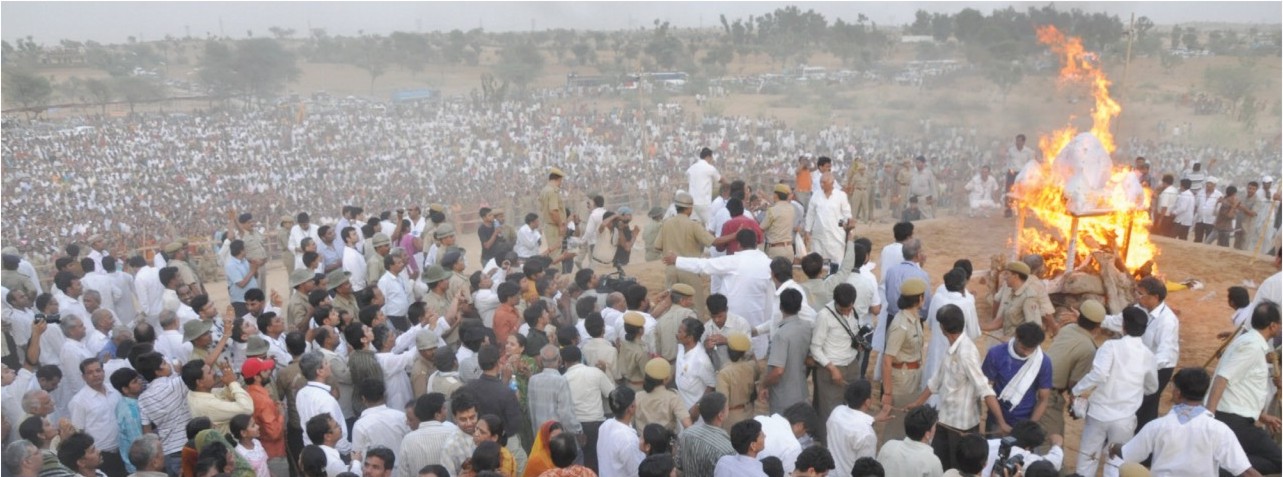
Fig. 9
Cremation of Ācārya Mahāprajña, Sardārśahar 10.5.2010 (Photo: Babluji)
References
- ĀvC = Āvassayacuṇṇi (Āvaśyakacūrṇi) by Jinadāsa Gaṇi Mahattara. 7th C. In: Śrīmadāvaśyakasūtram. 2 Vols. Prakāśikā: Ṛṣabhadeva Keśarīmal. Ratlām: Ṛṣabhadeva Keśarīmala Saṃsthā, 1928-29.
- ĀvN = Āvassayanijjutti (Āvaśyakaniryukti) by Bhadrabāhu. 1st-5th C. In: Śrīmad-Āvaśyakasūtram (Prathamo & Pūrva Vibhāgaḥ). Ed. Cunīlāla Pannālāla Javherī. Mumbaī: Nirṇayasāgara Press, 1916 (Āgamodaya-samiti-siddhānta-saṃgrahe Aṅkaḥ 1).
- ĀP = Ādipurāṇa by Jinasena. 9th C. In: Ācārya JinasenaKṛta Ādipurāṇa. Bhāga I-II. Hindī Anuvāda, Prastāvanā Tathā Pariśiṣṭa Sahita. Sampādana Anuvāda: Pannālāl Jain. Naī Dillī: Bhāratīya Jñānapīṭha, 1950 / 1996.
- Balbir, Nalini. "An Investigation of Textual Sources on the samavasaraṇa ('The Holy Assembly of the Jina')." Festschrift Klaus Bruhn zur Vollendung des 65. Lebensjahres dargebracht von Schülern, Freunden und Kollegen. Hg. Nalini Balbir & Joachim K. Bautze, 67104. Reinbek: Dr. Inge Wezler, 1994.
- Bareau, André. Recherches sur la biographie du Buddha dans les sūtrapiṭaka et les vinayapiṭaka anciens: II. Les derniers mois, le parinirvāṇa et les funérailles. Tome I-II. Paris: Éole Française D'Extrême-Orient, 1970, 1971.
- BKB = Bṛhatkalpabhāṣyam. Hindī Anuvāda Sahita. Vācanā Pramukha: Gaṇādhipati Tulsī. Pradhān Sampādaka: Ācārya Mahāprajña. Sampādaka / Anuvādaka: Muni Dulaharāja. Sahayogī: Muni Rājendrakumāra & Muni Jitendrakumāra. Khaṇḍ 1-2. Uddeśaka 1-6. Lāḍnūṃ: Jain Viśva Bhāratī, 2007.
- BKS = Kappa (Bṛhatkalpasūtra). In: BKB.
- Budhmal, Muni. Terāpanth kā Itihās. Pratham Khaṇḍ: Terāpanth ke Pratham Cār Ācārya. 4th Revised Edition. Calcutta: Jain Śvetāmbar Terāpanth Mahāsabhā Prakāśan, 1964 / 1995.
- Caland, Willem. Die altindischen Todten- und Bestattungsgebräuche, mit Benutzung handschriftlicher Quellen. Verhandelingen der Koninklijke Akademie van Wetenschappen te Amsterdam. Afdeeling Letterkunde. Deel I. No. 6. Amsterdam: Johannes Müller, 1896.
- Campbell, James M. (ed.). Gazetteer of the Bombay Presidency, Vol. XXIV, Kolhápur. Bombay: Government Central Press, 1886.
- Caturvedī, Kamaleś. "[Ācārya Mahāprajña] Mahāprayāṇa Yātrā: Kuch Ullekhanīya Tathya." Vijñapti 16, 7 (23-29 May) (2010) 6-10.
- Dundas, Paul. "A Neglected Śvetāmbara Narrative Collection: Hemacandrasūri Maladhārin's Upadeśamālāsvopajñavṛtti Part 1 (With an Appendix on the Funeral of Abhayadevasūri Maladhārin)." International Journal of Jaina Studies (Online) 9, 2 (2013) 1-47.
- Kamptz, Kurt von. Über die vom Sterbefasten handelnden älteren Painna des Jaina-Kanons. Hamburg, 1929.
- Kapferer, Bruce. The Feast of the Sorcerer: Practices of Consciousness and Power. Chicago: University of Chicago Press, 1997.
- Keyes, Charles F. "Tug-Of-War for Merit: Cremation of a Senior Monk." Journal of the Siam Society 63 (1975) 44-66.
- Kirfel, Willibald. Symbolik des Hinduismus und des Jainismus. Symbolik der Religionen. Band 19. Hg. Volker Möller. Stuttgart: Anton Hiersemann, 1959.
- Koppedrayer, K. I. "Are Śūdras Entitled to Ride in the Palanquin?" Contributions to Indian Sociology (N.S.) 25, 2 (1991) 191210.
- Levin, Mary. "Mummification and Cremation in India." Man 30 (1930) 29-34, 44-48, 64-66.
- Madhukar, Muni "Gurudev Śrī Tulsī kā Mahāprayāṇ." Naitikatā kā Śaktipīṭh. Pradhān Sampādak: Siddhrāj Vyās, 35-42. Gaṅgāśahar: Dr. Siddhrāj, 2001.
- Oldenberg, Hermann. Die Religion des Veda. Zweite Auflage. Stuttgart & Berlin: J.G. Cottaische Buchhandlung Nachfolge, (1894) 1917.
- Nabokov, Isabelle. "Deadly Power: A Funeral to Counter Sorcery in South India." American Ethnologist 27, 1 (2000) 147-169.
- Norman, Harry Campbell. "Gandhakuṭī - the Buddha's Private Abode." Journal of the Proceedings of the Asiatic Society of Bengal (N.S.) 4 (1908) 1-5.
- Parry, Jonathan P. Death in Banaras. Cambridge: Cambridge University Press, 1994.
- Patel, Gautam. "The Concept of Vakuṇṭha A Later Development." Journal of the Oriental Institute Baroda 35, 3-4 (1986) 163-169.
- Rām = Valmiki's Ramayana. Translated and Presented by Desiraju Hanumanta Rao & K. M. K. Murthy. www.valmikiramayan.net/
- ṚV = Der Rig-Veda. Aus dem Sanskrit ins Deutsche übersetzt und mit einem laufenden Kommentar versehen von Karl Friedrich Geldner. Cambridge, Massachusetts: Harvard University Press, 1923 / 2003.
- Schopen, Gregory. "The Buddha as an Owner of Property and Permanent Resident in Medieval Indian Monasteries." Journal of Indian Philosophy 18 (1990) 181-217 (Reprinted in: Bones, Stones, and Buddhist Monks, 259-289. Honolulu: University of Hawai'i Press, 1997).
- Shah, Umakand Premanand. Studies in Jaina Art. Benares: Pārśvanātha Vidyāpīṭha, 1955 / 1998.
- Sharma, L. P. Advent and Growth of the Terapanth Jain Sect: A Comprehensive Historical Study. Ph.D. Dissertation, Jodhpur University, 1991.
- Singh, Munshi Hardyal. Report on the Census of 1891. Vol. II. The Castes of Marwar. Illustrated. Jodhpur: Published by the Order of the Marwar Darbar, 1894.
- Stevenson, Sinclair. Notes on Modern Jainism with Special Reference to the Śvetāmbara, Digambara and Sthānakavāsi Sects. Oxford: B. H. Blackwell, 1910.
- Strong, John S. "'Gandhakuṭī': The Perfumed Chamber of the Buddha." History of Religions 16, 4 (1977) 390-406.
- TŚPC = Johnson, Helen M. The Lives of Sixty-three Illustrious Persons (6 Vols.). Translation of Hemacandra's Triṣaṣṭiśalākāpuruṣacaritra. Baroda: Oriental Institute, 1931-1962.
- Waldschmidt, Ernst. Die Überlieferung vom Lebensende des Buddha. Eine Vergleichende Analyse des Mahāparinirvāṇasūtra und seiner Textentsprechungen. Zwei Teile, Vorgangsgruppen I-IV und V-VI. Göttingen: Vandenhoeck & Ruprecht, 1944-48.
- Das Mahāparinirvāṇasūtra. I-III. Berlin: Akademie Verlag, 1950-51.
Research was co-funded by AHRC Fellowship AH/I002405/1 2011. All Āgama-References in the text refer to the Lāḍnūṃ-Edition.
See Waldschmidt 1948: 277-9, 1950: 410ff., and Bareau 1971: 192, 194f., who regarded the difference between a palanquin and a simple bier as negligible.
"Their dead bodies are carried by the [Jodhpur Dhundia] Jains [...] in a Bekunti, and burnt" (Singh 1894: 97).
Campbell 1886: 145 observed in 19th century Kolhapur: "When a [Digambara Jaina] sanyáshi or ascetic dies his body is carried in a canopied chair instead of an ordinary bier."
In Vedic India women also participated in funeral processions. See Āśvalāyanagṛhyasūtra IV.4.2. Cf. ṚV 10 and Atharvaveda 18, etc., for further older information on Vedic funerals.
Uv 16 mentions the following set of (non-violent) royal symbols appearing in the sky wherever Mahāvīra went: wheel (cakka), umbrella (chatta), flywhisks (cāmara), crystal lion-throne (sīhāsaṇa) with footrest (pāya-pīḍha), and religious flag (dhammi-jjhaya).
Both images were kindly shared with me by Phyllis Granoff. For the older one, from Cambay, see Fig. 5. The latter one is from a Sthānakavāsī text, the Rāmayaśorasāyana by Muni Keśarāja, edited by J.P. Jain (n.d.), p. 189.
Stevenson 1910: 28 writes, that the top of the funeral palanquin for the dead Sthānakavāsī sādhvī in Kāṭhiavāḍ, "resembled a temple, with numerous pinnacles each bearing a flag, while the inside was lined with exquisite silk and rich cushions."
Budhmal 1995: 326. Cf. TŚPC 13.253, translated by Johnson 1962 VI: 351, on Ṛṣabha's corpse: "Śakra laid the Lord's body on a bier that was equal to the best areal car."
Under this title 7 of the 8 were separated out in later texts: 1. aśokavṛkṣa, "Aśoka-tree," 2. sura-puṣpa-vṛṣṭi, "shower of flowers by the gods." 3. divya-dhvani, "heavenly sound," 4. cāmara, "fly-whisks," 5. siṃhāsaṇa, "lion-throne," 6. bhā-maṇḍala, "halo," 7. tri-chatra, "triple umbrella;" and supplemented with [8.] deva-dundubhi, "celestial drumbeating."
Cf. Rām II.67.30 on the flag as the distinctive mark (prajñānam) of the chariot, as smoke is for fire, and the king for the country.
According to Kirfel 1959: 155 kalaśas symbolise not only wellbeing, but also clairvoyance (avadhi-jñāna) of the arhats.
According to Sharma 1991: 93, Ācārya Bhikṣu's baikuṇṭhī had 13 pinnacles (monastic age: 52), Jītmal's "51" (monastic age: 69). The protocol of Ācārya Jītmal's funeral by contrast notes the "59 kalaśas" (Budhmal 1995: 535), and the golden crest of his baikuṇṭhī. Ācārya Mahāprajña's baikuṇṭhī featured 61 kalaśas (monastic age: 79) (Caturvedī 2010: 10).
See Oldenberg 1894 / 1917: 574 on the recitation of ṚV 10.14.7 at this stage and the supposedly magical effect of the procession to the cremation site for the advancement of the 'soul' on its path of which it represents the beginning; and Caland 1896 § 11: 20 on the late Vedic funerary cart (śakaṭam, anaḥ) which is explicitly described as a vehicle for the deceased to travel to the realm of Yama.
Cf. Levin 1930: 31f. for similar practices in Burma. Kapferer 1997: 174 describes the ritual destruction of a similar model of a royal palace in a Buddhist anti-sorcery ritual in Śrī Laṅkā and its associations with dead and regeneration. For the role of pseudo-funerals as rites of passage, see also Nabokov's 2000: 157 study of anti-sorcery rites in South India.
 Dr. Peter Flügel
Dr. Peter Flügel